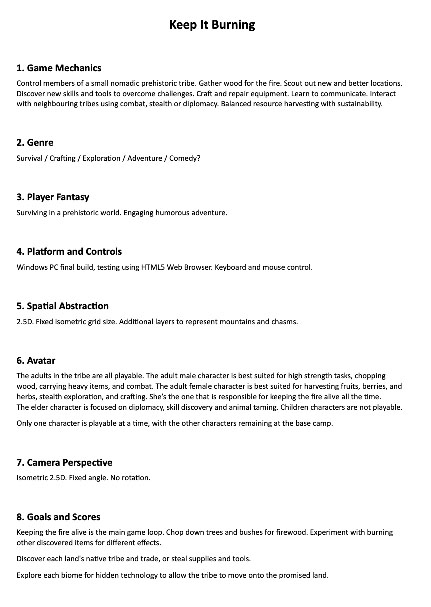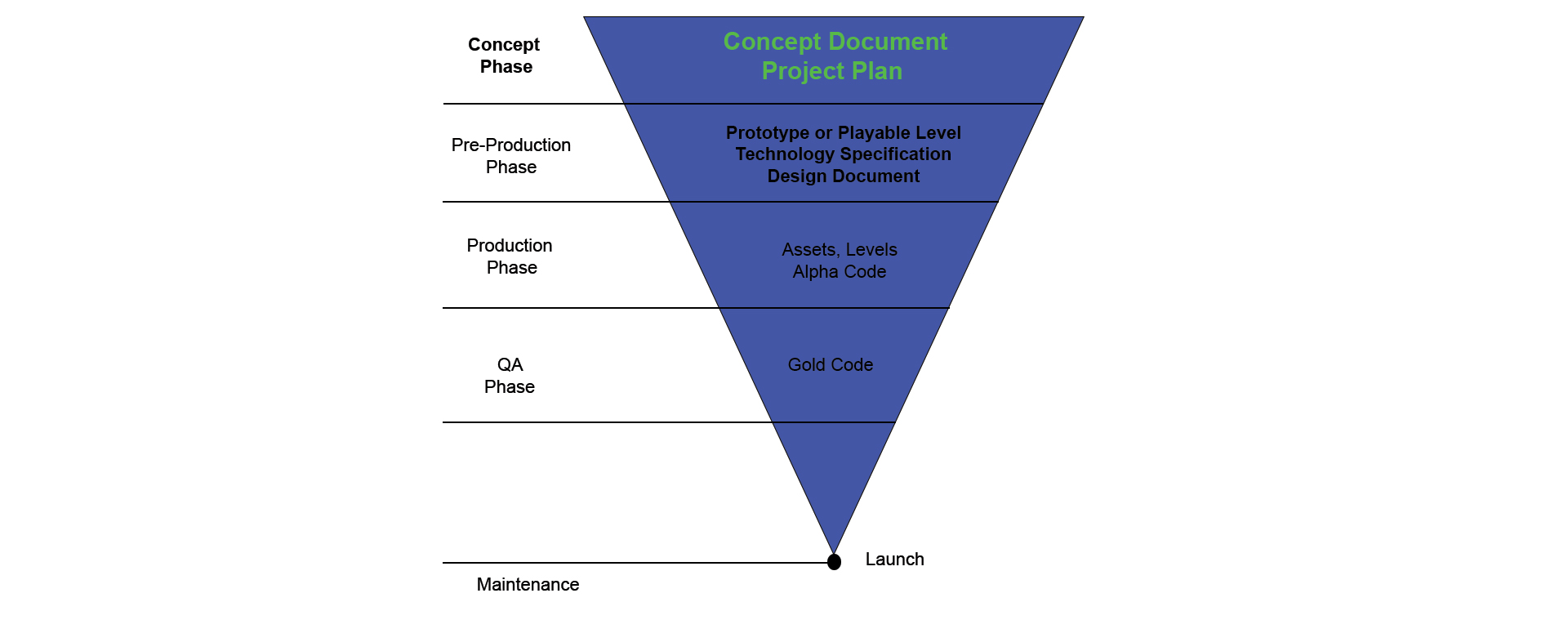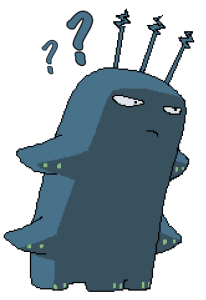
Without any prior warning, surprisingly, our team suffers the first ‘casualty.’
Waite a minute, what is going on here?
Four Musketeers!
So our team leader just dropped the group.
A week after this shocking news, and without any official or unofficial explanation, we have decided to continue with the project without waiting for her to get back or have an eventual replacement.
In this way, we took the initiative and started redistributing the tasks emphasising improving communication. This directly leads me to the issue I would like to focus on in this section. The whole situation made us miss several workdays and have an extra 25% of personal burden unexpectedly. Therefore, it was the right moment to take action quickly.
After the pandemic, the use of social media and online meetings is at its peak. All new technology has an impact on people’s behaviour which implies both positive and negative aspects.
Online communications might be effective, but they deprive us of another kind of essential knowledge: clear gestural information, which is easy to gather -most of the time unconsciously- when sharing the same physical work environment or just a simple conversation in the cafeteria, but not so much on a bit of window on a corner of the screen.
Even worst, in many cases, reviewing the recorded conversation repeatedly can cause to lose context and enter into a whirlwind of interpretations bordering on paranoia. Sounds extreme? Not so much in our experience. Text messages through chat or mail are often misunderstood when there is no proper reference concerning the sender and the other way around.
Personally speaking, I have noticed that these kinds of situations encourages parallel message exchanges between colleagues (those who are in the same time zone or among who share a greater degree of trust) using alternative channels of communication, taking for granted of all sorts of assumptions and possible scenarios, with the well-known waste of time and energy that this entails. I do believe that any team working only on remote will never perform at its fullest.
Having to wait several hours / days to confirm that a given job has been completed is not the best option for people with obsessive behaviours or anxiety troubles. Thus, though making use of a Kanban system that is thorough and flexible, things can get complicated very fast, and repeated efforts gains ground especially when some members decide to supply the work assigned to another person, on their own initiative.
Specifically speaking, I have noticed all those counterproductive signs, but I decided to ignore this to avoid additional frictions.
Big mistake!
In fact, on more than one an occasion, I preferred to keep silence so as not to hurt other people’s feelings or lead to conflict, and I’m pretty sure that most of us do not dare to say what we really feel, owing to the fear of ‘sinking the boat’.
Without going any further, this situation was pushed over the edge by the person who not only quit the group untimely without expressing her real feelings. Or any other though to be precise.
The five most common dysfunctions on groups
This week’s reading, related to the five most common dysfunctions, was quite revealing. Though we tried to pay attention to these issues in our group, I believe that most of the texts I consulted refer to traditional working environments. In our case, this is slightly different not only because of the virtuality we depend on, but also because of the fundamental nature of our student condition.
This is not my first experience studying online: I got a character animation diploma from a well known animation school and I use to take at least two virtual courses at year, with some amazing mentors from the industry as this one about compositing with Nuke by Nick Chamberlain or BrandX by Allan McKay about build a personal brand from my experience.
Some people take this learning experience as a simulation of the ‘real world’ or like a ‘real job’ carried out in an office or company. Others push themselves to be the best in the class and do their homework to the letter. A small number of people considers this as an ideal situation to fail, to experiment, to make mistakes and learn from them, daring to break the rules and facing consequences, as I have tendency to do.
Talent is always a key ingredient to team building, and, of course, you want the most talented individuals you can find. But talent only goes so far. Finding the right mix of talent and personality is even more crucial. Some people are brilliant at what they do individually, but, when put on a team, they are unable to interact productively with their team- mates and cause more trouble than their contribution is worth. (Fullerton 2008 :368)
In any case, and talking about what I have been experiencing as a part of this group so far, these feelings of enjoyment and enthusiasm have been overshadowed by both the obsession and the pressing need to meet the requirements of the class, which are not few and take a lot of time to comply with. Owing to all this, no one is exempt from losing control, energy, or motivation to move forward at any time, including me.
Rapid ideation plan (Part 2)
Iterative design is a cycle of conceptualization, prototyping, testing, and evaluation. Iteration is an adaptive process whereby designers move through cycles of conceiving of an idea, creating a prototype that embodies the idea, running play tests with the prototype to see the idea in action, and then evaluating the results to make the idea better. (Macklin 2016 :194-195)
During the few days that we worked as a group of five members, we had the opportunity to propose 6 ideas each, all of them detailed on a Miro board devoted to brainstorming activities (to better illustrate these concepts, I proposed to attach examples of similar games).
Although there was never formal discussion of having to post half a dozen ideas each, no one wanted to be left behind and soon the board was full of notes and fantastic ideations!
I was very excited with one of Phil’s proposals about an ‘end of the world simulator‘ with the goal to achieve the end of the world as fast as possible. It sounded very funny to develop, but at the same time very difficult to constraint into something that we could make given the time and our skills. It looked insanely ambitious to me, and very attractive at the same time.
Generate more and more ideas turned out to be quite tricky, and overall, two of my six proposals seemed interesting enough to me to try to convince the others to vote for them… why not?
Representations in games do not exist in isolation from the rest of culture. They rely on conventions drawn from narrative genres in other media. Although the playgrounds of games may offer fictive and fantastical spaces, these spaces are almost always familiar in some way to players.
In order to understand the setting of a game world, players rely on knowledge from other, similar stories. The narrative knowledge that players bring with them to games not only helps them recognize the conventions of the game universe, but also limits and constrains their actions. (Salen 2004 :496)
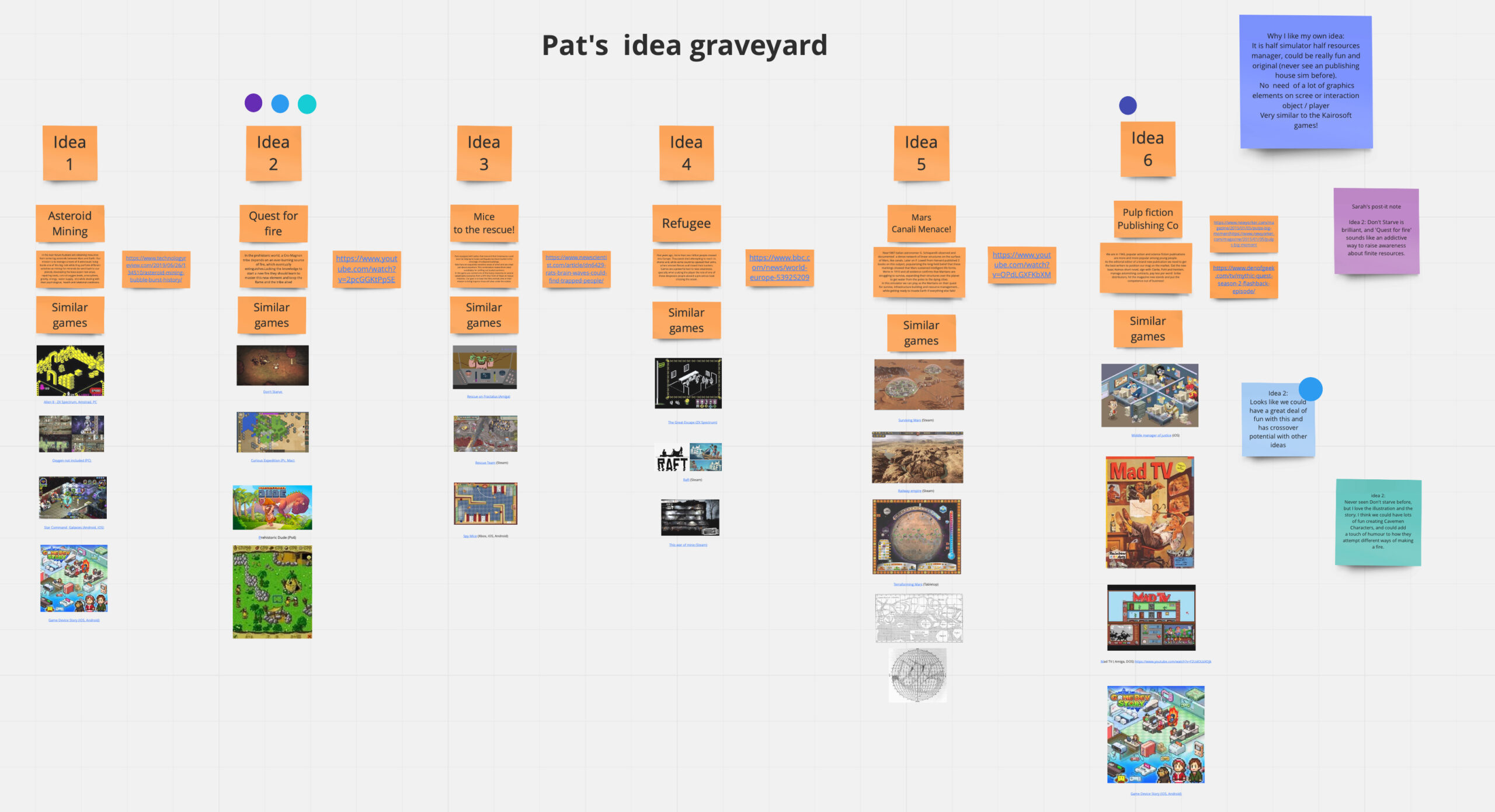
I had ‘Refugees’, a game about the harsh reality of those who leave their country to seek a better future in European lands, risking their lives crossing the ocean in lousy condition boats or desperately crossing the borders without thinking of the consequences.
Due to this delicate issue, it was a highly complicated challenge to bring up. But, anyway, it was a challenge worth exploring. Games are a powerful tool to raise awareness, especially when putting the player in a role with clear social commitments.
Another concept, less socially committed, was Pulp Magazine Publishing Simulator, a kind of simulator that appeared in pulp magazines in the mid-1940s. As a former magazine editor, I got very enthusiastic about this!
In just a few hours 30 exciting ideas came up during our brainstorming sessions. All of them were worth being developed. So we decided to carry out two voting rounds. The first step was to select a candidate among 6 of each participants. The second would be to pick ‘the winning concept’ and devoting our total effort to achieve a playable demo from it and we were eager to present as elaborate a concept as possible to our supervisor, Giovanni Rubino, during our next Monday session.
If you are interested on reading all about my brainstorming ideations in more detail this pdf document is what you’re looking for.
Game design documentation GDD
Team members might end up with different understandings of the game, duplicate work might get done, or even worse, work might not get done at all. To help keep everyone on the same page, we use three interrelated documentation methods: design documents, schematics, and tracking spreadsheets. The game design document is a useful tool to help game designers turn ideas, inspirations, and design values into more structured designs. Design documents capture decisions and turn them into concrete plans for a game’s design that serve as a reference for everyone on the team. Without a game design document, moving through the iterative design process can be confusing and hard to keep track of. The team, or even a game maker working alone, will be left to rely on memory and the not fully explored ideas that seemed so excellent in the spur of the moment. (Macklin 2016 :235 – 236)
At first glance we assumed that this game document should explore every detail of a game, but this should not be the case as for many indie games or for small projects. Finding the right level of detail for capturing the design is not easy, especially when working with a team. In our case we started with some tendency to add a lot of detail, but as we progress we achieved to put a good quantity of information. Read our Game Design Document here.
My personal contribution to the project (2): artefact concept
To my surprise, one my proposals become the chosen one: the story of a primitive clan at the dawn of humanity whose fate depending on constantly keeping the fire burning to survive the long nights and the harsh days of the Pleistocene.
That being said it is very important to mention that this approach was boosted as final, since it seemed to be the right one to hold an essential concept related to non-renewable resources (having to keep the fire burning all the time could potentially wipe out all the trees in the area or even undermine the values of other essentially arboreal life forms, causing floods, deforestation and a lot of other ecological issues). In the same way, Phil and Will suggested adding a crafting component to wrap up the idea.
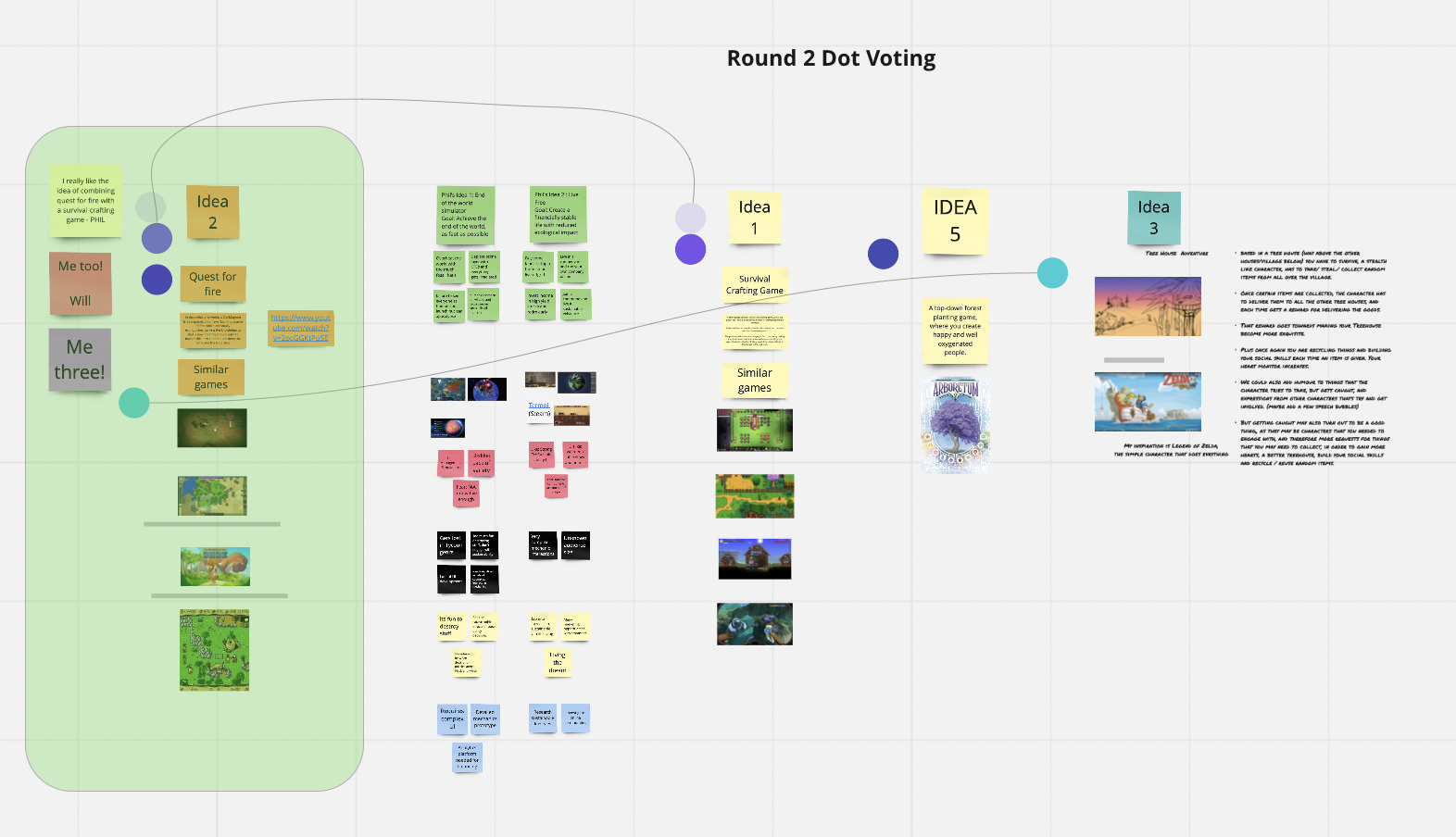
Overall, I was very enthusiastic about this straightforward and very clear premise: to keep the flame burning or you won’t survive as a tribe.
In my original concept, a female figure should be responsible for keeping the fire under control. I focused on the female figure because I thought it was really important to minimise the typical caveman’s role, aimed at protecting the tribe based on beat and hunting. In this way, the entire responsibility in relation to survival was linked to a woman.
This point was slightly controversial, and we could not conclude who would be the main character of the game. So we decided that the player would go with two characters, with different abilities and responsibilities.
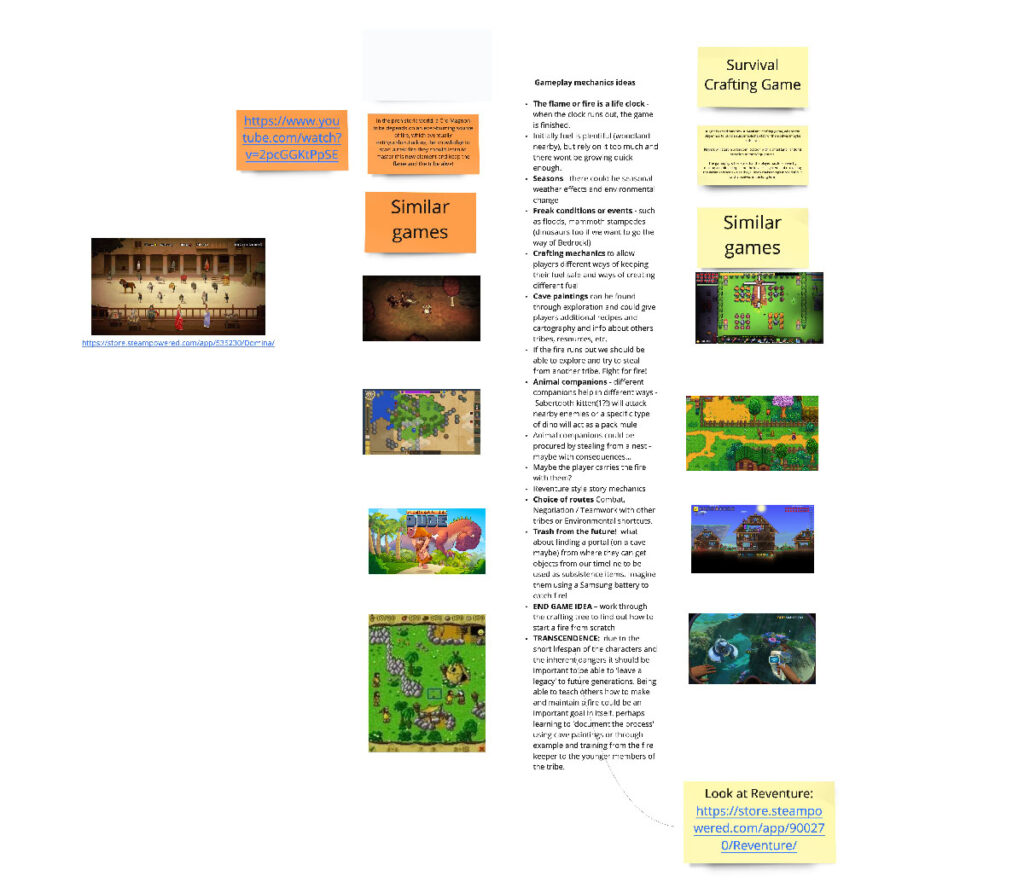
The name
Try to name your game sooner than later. I have always preferred the titles developers created over those made up by someone else in the team. If you wait too long, a publisher’s marketing department will have to come up with the game’s name for you—and believe me, you don’t want that. (Rogers 2010 :50)
Finding the right name for the artefact was another challenge in itself, as expected. Over the course of several days, we jotted down ideas for a vote. As time went by, the tedium became quite evident: no proposal was to everyone’s liking. Somewhat frustrated, we decided to put the name issue on hold for a while. It wasn’t until several days later that a little phrase I wrote with the intention of encouraging the group gave us the answer: Keep it burning!
After that, my next idea was to do an internet search on other products with this name and to my astonishment; I only found some barbecue products and an unused internet domain for sale. As the cost of it was quite high, I ended up acquiring the alternative www.keepitburningthegame.com, which for all purposes was more practical.
Going isometric
The unanimous choice to use the isometric projection for the game levels was something pleasantly surprising to me. I was waiting such a challenge for years. As well as my collaborators in the group, this way of introducing the characters, settings and the narration on the screen is linked to our best memories from those days in which we enjoyed those legendary titles of the 8 and 16 bits.
If you choose a pixel art style, players may assume the game will feel retro or have a hardcore difficulty level (Maine 2020)
Such was the desire to make an isometric game that nobody hesitated to give up the original plan of developing the prototype in Game Maker Studio 2 to switch back to Unity, despite Phil and Will have more experience with the first creation engine. Unity, unlike Game Maker, counts on a native set of tools that make it easier to use the isometric elements.
Unity is an extremely popular game engine that affords a huge number of advantages over other game engines available in the market today. Unity offers a visual workflow with drag-and-drop capabilities and supports scripting with C#, a very popular programming language. Unity has long supported 3D and 2D graphics, and the toolsets for both grow more sophisticated and user-friendly with each release. Unity has several tiers of licenses and is free for projects with revenues up to $100k. It offers cross-platform support for 27 different platforms and takes advantage of graphics APIs specific to the system architecture, including Direct3D, OpenGL, Vulkan, Metal, and several others. Unity Teams offers cloud-based project collaboration and continuous integration. (Halpern 2019 :10)
Isometric drawing, also called isometric projection, is a 3D representation of an object on a 2D surface. One of the defining characteristics of an isometric drawing, compared to other types of 3D representation, is that the final image is not distorted. The technique is intended to combine the illusion of depth, as in a perspective rendering, with the undistorted presentation of the object’s principal dimensions, that is, those parallel to a chosen set of three mutually perpendicular coordinate axes. In an isometric drawing of a cube, the three visible faces appear as equilateral parallelograms; that is, while all of the parallel edges of the cube are projected as parallel lines, the horizontal edges are drawn at an angle (usually 30°) from the normal horizontal axes, and the vertical edges, which are parallel to the principal axes, appear in their true proportions. By the same token, an isometric view is a display method used to create an illusion of 3D for an otherwise 2D representation – sometimes referred to as pseudo 3D or 2.5D
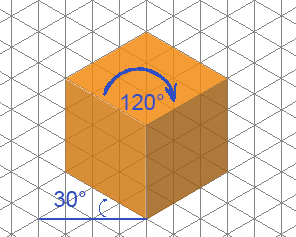
In games, there is a few technical ways to accomplish to this, being the most popular the tile-based approach where each visual element is broken down into small pieces, called tiles, of a standard size. These tiles will be arranged to form the game world according to pre-determined level data – usually a 2D array. The we angle the camera along two axes (swing the camera 45 degrees to one side, then 30 degrees down), creating a rhombus shaped grid where the grid spaces are twice as wide as they are tall. Using isometric projection gives games a sensation of being three-dimensional but without all the extra math computation in- volved in showing overlapping 3D objects moving around in real space with realistic lighting effects. (Moore 2011 :294)
Isometric games were trendy in the mid-eighties, especially on the ZX Spectrum Catalogue; being Ultimate Play the Game and Ocean, the firms responsible for taking this art form to its limits given the technological capabilities of the time with titles like Knight Lore, Fairlight, Nightshade or Alien 8. Later on Jon Ritman and Bernie Drummond added graphical detail and amazing pixel art animations with Batman and Head over Heels, released by Ocean Software, just to name a few. This style was also popularized by strategy games and action RPGs later on. Another approach to two-dimensional maps is to show them tilted at an angle and viewed from above the ground plane. This view uses isometric projection to give a sense of pseudo-3D to the play- field and dates back in games to 1982 with the release of Q*bert by Gottlieb and Zaxxon featured by Sega.

For more detailed information about isometric projections in games I would like to recommend the following article by Clint Bellanger and The Complete Guide to Isometric Pixel Art
With the introduction of the Tilemap feature in Unity it is relatively easy to create isometric levels natively instead of relaying on outside tools. I also researched some third-party isometric engines on Unity’s asset store, and I only find this tool that, after some testing, was not good enough for our needs. Good to know that there’s a clear niche here that can be explored in a commercial way in the future.
Today just ideas, in a few weeks a game?
Once we had a potential list of features to start working with we spent some time refining some important questions before start thinking on game mechanics. The temptation to jump into Unity and just skip this step is undeniable but we must learn from past experiences and be guided by what professionals and literature recommend at this stage. I found chapter 6 of the ‘Game Design Workshop‘ by Tracy Fullerton very appropriated; the author proposes to focus on the formal elements. Those elements are the underlying system and mechanics of the game, and to find them, we should answer some of the following questions first:
- What is the conflict in my game?
Our main character and his family depend on fire to stay alive without exhausting all the resources on the entourage. Constant threat of the fire burning out due to weather conditions and personal skills.
- What actions do the players take and when?
Gather wood for the fire. Scout out new and better locations. Discover new skills and tools to overcome challenges. Craft and repair equipment. Learn to communicate. Interact with neighbouring tribes using combat, stealth or diplomacy. Balanced resource harvesting with sustainability. - How many players can play?
One in the demo, up to three on the final release. - Who is the target audience?
The game will be suitable for all age groups (PEGI 3), very mild form of violence (in a comical context or a childlike setting). - What platform will this game run on?
Mac and Windows.
Is okay if you do not know all the answers at this point in the process. In the beginning, you can only guess, and you won’t know if you are on the right track until you actually play the game and see how it works. But do not let this stop you from conceptualizing the game. You might be working blind at first, but soon the game will begin to take form. (Fullerton 2008 :163)
Once agreed on these points, the next stage involved using the ‘Six thinking hats’ technique to find the strengths and weaknesses of our approach. But all this coincided with the sudden leaving of group leader.
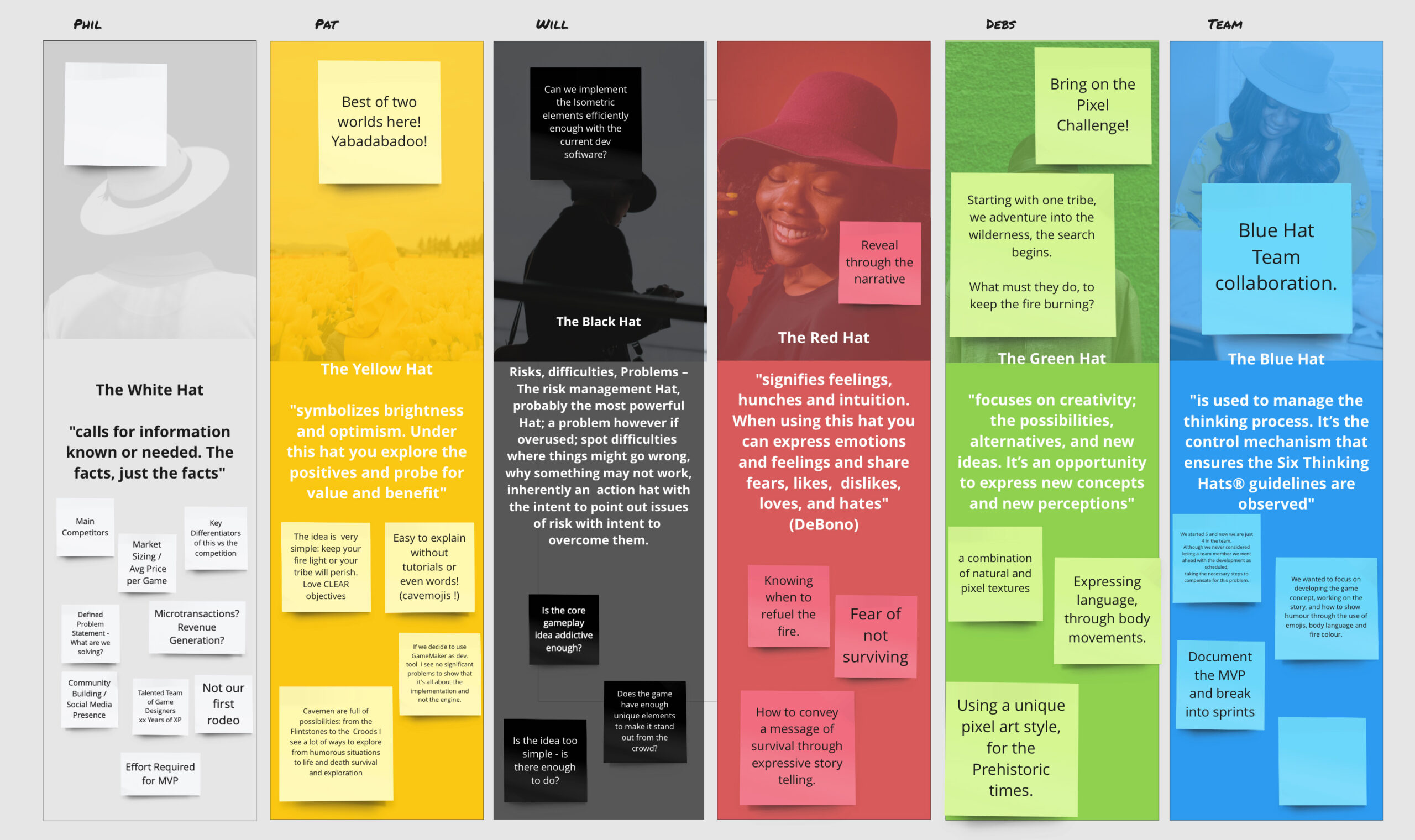
This last chart from this entry reflects the team performance up to this day in based on my own observations (pink triangle).
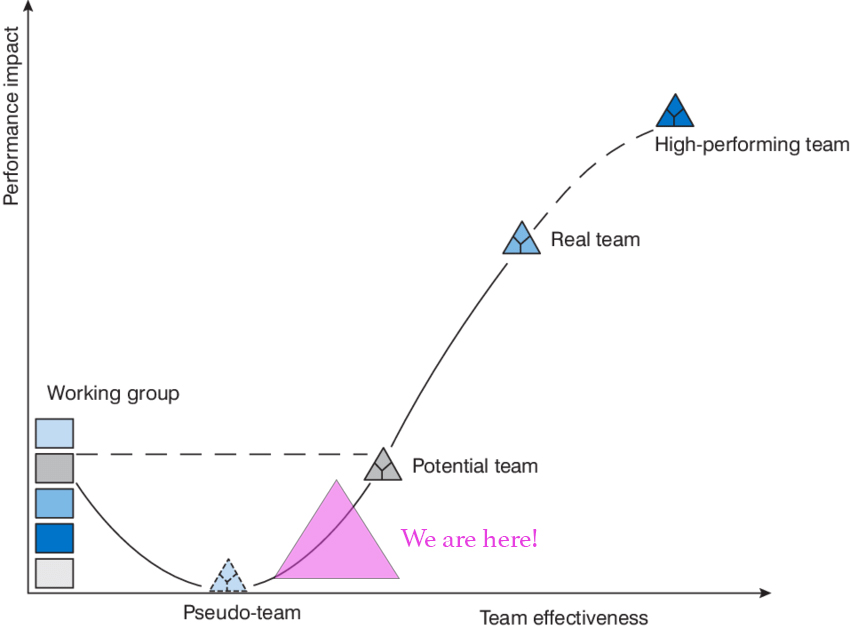
And from this moment on, suddenly, all the hats flew away! (see next entry).
List of figures
Fig 1 – Miro board with brainstorming ideas. Screen capture by the author.
Fig 2 – Game Design Document. By the Wild Branch Team.
Fig 3 – Mechanic ideas board. Image capture by the author.
Fig 4 – Miro board including the 5 semi final ideas submitted to vote by the team. Screen capture by the author.
Fig 5 – An isometric representation of a cube.
Fig 6 – Early isometric games for the ZX Spectrum: Knight Lore (c) Ultimate Play the Game, The great escape, Batman and Head over Heels (c) Ocean Software and Hydrofool (c) Gargoyle Games / Faster Than Light.
Fig 7 – Stage of development for Keep it Burning based upon Fullerton’s scheme. (c) Fullerton 2008.
Fig 8 – Six thinking hats board by the Wild Branch. Capture by the author.
Fig 9 – Team Performance Curve for The Wild Branch based upon Katzenback and Smith scheme.
References
Davis, R. 2004. ‘The Complete Guide to Isometric Pixel Art’.[online]. Available at: <http://www.gotoandplay.it/_articles/2004/10/tcgtipa.php>
Halpern J, 2019. ‘Developing 2D Games with Unity: Independent Game Programming with C#‘. Apress Publishing
Salen K, Zimmerman E. 2004.’Rules of Play: Game Design Fundamentals‘. The MIT Press.
Bellanger C. ”Isometric Tiles Introduction‘.[online]. Available at: <http://clintbellanger.net/articles/isometric_intro/> [accessed 4 June 2021]
Macklin C, Sharp J. 2016. ‘Games, Designs and Play A Detailed Approach To Iterative Game Design‘. Published by Pearson Education Inc.
Bellanger C. ‘Isometric Tile Maths‘. [online]. Available at: <http://clintbellanger.net/articles/isometric_math/> [accessed 4 June 2021]
Pagella, M. 2011. ‘Making Isometric Social Real-Time Games’. Published by O’Reilly Media, Inc.
Rogers, S. 2010. ‘Level Up The Guide to Great Game Design‘. Published by Wiley & Sons, Ltd.
Fullerton T. 2008. ‘Game Design Workshop A Playcentric Approach Creating Innovative Games ‘ – Second Edition. Published by Morgan Kaufmann Publishers.
